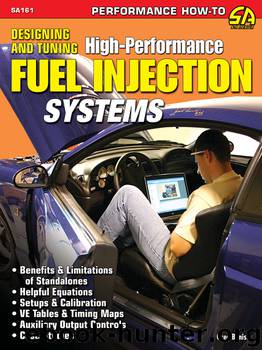Designing and Tuning High-Performance Fuel Injection Systems by Banish Greg

Author:Banish, Greg [Banish, Greg]
Language: eng
Format: epub
ISBN: 978-1-61325-020-4
Publisher: CarTech Inc.
Published: 2009-11-20T16:00:00+00:00
A digital volt-ohm meter (DVOM) can be a very useful tool for diagnosing simple signal error and possible short or open circuits. It’s a good idea to always check against a known value such as a good 12v battery to verify proper operation of the DVOM before taking other system voltage measurements.
Additional Equipment
While a laptop, wideband, and dynamometer cover the vast majority of calibration needs, it’s also handy to have some additional tools to make sure things are really as they seem. I like to think of these as the “reality check” tools. These are tools used to make sure that the calibration values being entered into the ECU are actually performing as intended.
The first of these tools is the timing light. Before the advent of the ECU, the timing light was the primary tool for tuning. Today, it’s still important because there still exists the potential for error in any system. Before spending hours on the dyno adjusting spark maps, it’s always a good idea to make sure that the values in the table are actually what is being delivered to the plugs. Most ECUs have the ability to set timing to a constant value for diagnostic purposes. Confirming that 10 degrees BTDC is really 10 degrees BTDC goes a long way toward preventing some unregulated anger later on. The timing light is the most useful means of ensuring that the crank and cam sensor inputs are being properly registered by the ECU since spark delivery is directly tied to their inputs. Occasionally, a bad outboard ignition module can be diagnosed by a varying offset in delivered ignition timing. The point here is to make sure that the calibrator is really in control with the spark advance tables in the ECU. Remember that the delivered timing may be more than just the base spark table value once the adders (modifier values from other tables that are used to adjust the base table value) for temperature, air/fuel ratio, barometric pressure, and idle control are active.
The most flexible electronic tool is probably the DVOM, or digital volt-ohm meter. Every tuner should have one in his toolkit. Most sensors on the engine have voltage based outputs, so they can be checked with the meter independent of the ECU connection. A sensor with a short or open circuit can be quickly diagnosed using this simple tool. Likewise, variable sensors like the TPS can be swept through their range and tested for individual broken traces that would otherwise appear as random cutouts while driving. The ECU itself and harness can be tested to make sure that the 5v reference voltage is available at each sensor connection as well. Alternator output and battery voltage can also be real concerns when tuning, so don’t overlook the simplest of uses. In a pinch, the test light serves as an even simpler check.
What dynamometer test cell would be complete without a few gauges? In most well-equipped test cells, the computer running the dynamometer also has multiple analog input ports that can be used to track additional sensors.
Download
This site does not store any files on its server. We only index and link to content provided by other sites. Please contact the content providers to delete copyright contents if any and email us, we'll remove relevant links or contents immediately.
| Automotive | Engineering |
| Transportation |
Machine Learning at Scale with H2O by Gregory Keys | David Whiting(4256)
Never by Ken Follett(3874)
Urban Outlaw by Magnus Walker(3361)
OPNsense Beginner to Professional by Julio Cesar Bueno de Camargo(3260)
Sapiens and Homo Deus by Yuval Noah Harari(3024)
Will by Will Smith(2869)
A Short History of Nearly Everything by Bryson Bill(2653)
Hooked: A Dark, Contemporary Romance (Never After Series) by Emily McIntire(2527)
Rationality by Steven Pinker(2323)
Borders by unknow(2278)
The Becoming by Nora Roberts(2145)
Holy Bible (NIV) by Zondervan(2100)
HBR's 10 Must Reads 2022 by Harvard Business Review(1818)
A Short History of War by Jeremy Black(1814)
The One Percenter Encyclopedia by Bill Hayes(1810)
Freedom by Sonny Barger(1783)
Go Tell the Bees That I Am Gone by Diana Gabaldon(1728)
Five Ways to Fall by K.A. Tucker(1723)
Girls Auto Clinic Glove Box Guide by Patrice Banks(1705)
